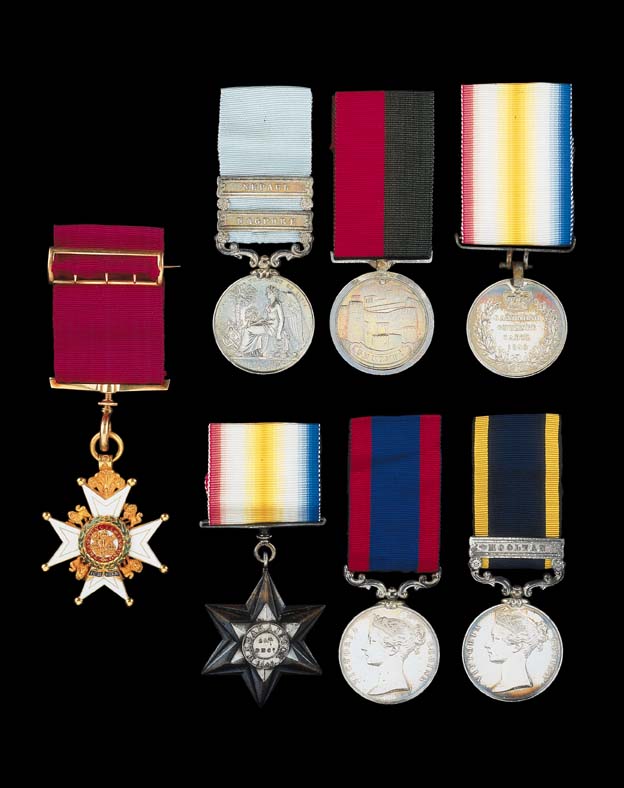
Auction: 4004 - Orders, Decorations, Campaign Medals & Militaria
Lot: 4
A Rare, Early Indian Campaign Group including a 'Sobraon' C.B. to Lieutenant General J. Nash, Bengal Army, a Distinguished Regimental Commander in the First Afghan War, the Gwalior Campaign and the First and Second Sikh Wars a)The Most Honourable Order of the Bath, Companion's (C.B.) breast Badge, Military Division, 22ct. gold (lion passant, leopard's head, sun assay, date letter and standard marks for London 1843-44, maker's mark WN), with gold riband buckle, in Garrard, Panton Street, London case of issue. b) Army of India 1799-1826, short hyphen reverse die type, two clasps, Nepaul, Nagpore (Ens. Josh. Nash 22nd N.I.), officially engraved c) Ghuznee 1839, unnamed as issued d) Candahar, Ghuznee, Cabul, 1842, with steel clip and straight bar suspension, unnamed as issued e) Maharajpoor Star 1843 (Major Commanding 43rd Reg. Light Infantry), with contemporary 'German silver' swivel bar suspension f) Sutlej 1845-46 for Sobraon 1846 (Major 43rd Regt. N.I) g) Punjab 1848-49, one clasp, Mooltan (Lieut. Col. C.B.72nd Bengal N.I.), the group good very fine and better, with comprehensive biographical details (7) Estimate £ 7,000-8,000 Lieutenant General Joseph Nash, C.B. born Failsworth, Lancashire, was admitted to the service of The Honourable East India Company, 1813 and was posted Ensign to the 2/7th Bengal Native Infantry, 1814; served throughout the Nepal campaign, 1814-15 and was present at the siege and capture of the fort of Malown; transferred to the 1/22nd Native Infantry, 1816 and served during the Third Mahratta War; accompanied the Nagpore Subsiduary Force and was present at the storming and the capture of three batteries and the enemy's camp 16 December, 1817 and took part in the storming of Nagpore 20 December (commended for his services on this occasion by General Sir J.W. Adams); commanded a company of Pioneers at the siege and capture of Asseeghur in the Deccan 1819 ( officially commended by Major General Sir J. Malcolm in Army Division Orders); commanded a company of Pioneers at the capture of Lainba during the operations in Jodphur; transferred to the 43rd Native Infantry later that year; advanced to Captain, 1829. Nash served with the Army of the Indus in the First Afghan War and took part in the first assault and capture of Ghuznee under Lord Keane 23.7.1839; was appointed to the command of Shah Shuja's Guard at Kabul (3rd Class Dooranee Empire granted but never received because of the King's assasination); advanced to Major 1841, rejoined the 43rd N.I. assumed command. Major Nash led his Regiment throughout the campaign in Afghanistan 1840-42 including the attack and repulse on the Cantonments at Candahar (wounded 29.5.1842) and the second capture of Ghuznee. On 15 September the 43rd N.I. detachment of cavalry and a Brigade of Guns commanded by Nash, whilst acting as rearguard to General Nott's army, were attacked by an overwhelming force of enemy Horse and Foot estimated at 8,000-the enemy was successfully repulsed (officially commended by General Nott). Nash was again brought to official notice in Major General McCask's Afghanistan Despatches for his conduct at the assault of the garrisoned town of Istaliff (London Gazette 6.12.1842). For distinguished services rendered in Afghanistan the 43rd on return to Hindoostan was given the title 'Light Infantry'. Nash led the 43rd Light Infantry at the battle of Maharjpoor December 1843 (Brevet Lieutenant Colonel) and two years later he led them again at the capture of the entrenched Sikh camp at Sobraon, where the regiment lost 106 officers and men and Nash had his charger killed under him (Mentioned in Despatches 13.2.1846; C.B. 30.6.1846), appointed Lieutenant Colonel commanding the 72nd N.I. at Mooltan from November, 1848 and on 27th of the following month commanded the Left Centre Column of attack in the assault and capture of suburbs (severely wounded); Lieutenant General, 1869. Lieutenant General Nash died 1870.
Sold for
£8,800




